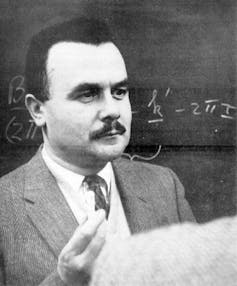Why Canada must not be shut out of the neutron technology it invented

The Chalk River Laboratories in 2012. Canada’s role as a world leader in neutron-scattering is at risk because of a failure to invest in infrastructure renewal at the facility.
December 12, 2017
In the 1950s, physicists at Canada’s Chalk River Laboratories, led by Bertram Brockhouse, developed an important new method that revealed the positions of
atoms and how they move in materials.
With his colleagues, Brockhouse – who would later share a Nobel Prize in Physics for his work – helped create a technique called neutron scattering, and specifically gave birth to neutron spectroscopy.
By directing a beam of neutrons at a sample material and measuring how the neutrons ricocheted off the atoms, and how they slowed down and sped up in the process, Brockhouse made it possible to look into materials and understand their atomic architecture and dynamics.
These pioneering neutron-scattering developments, first established at Chalk River’s National Research Universal (NRU) reactor in eastern Ontario and further developed at the McMaster Nuclear Reactor in Hamilton, Ont., were a creation of basic science.
What motivated Brockhouse (who joined the faculty at McMaster University in 1962) and his contemporaries was to understand the possibilities of neutron beam technology.

Today, neutron-scattering is recognized as an essential tool for understanding the structure and dynamics of materials, part of a suite of complementary techniques including synchrotron radiation and electron microscopy.
Some 60 years later, the discovery made by scientists at the Chalk River Laboratories is producing major scientific advances and delivering huge economic benefits all over the world.
Canada’s scientific and economic competitors, including the United States, the European Union, Japan, Australia and China, have developed and are making new investments in stand-alone neutron-scattering facilities. They do so frequently with the assistance of the Canadians who still know the technology best.
They are investing billions of dollars to access the information that neutron scattering alone can provide. That will allow them to understand, develop and perfect materials, from superconductors (materials with no electrical resistance) to auto parts, towards improving the quality of life for people everywhere.
Neutron scattering played an important part, for example, in the 1988 discovery of a scientific curiosity called giant magnetoresistance. By 1994, that basic science discovery, later recognized with the 2007 Nobel Prize in Physics, had become the platform of choice for data storage in our computers, tablets and cellphones.
Future in doubt in Canada
While neutron scattering continues to grow in importance and Canada enjoys international recognition as its ancestral home, its future here in Canada is nonetheless very much in doubt.
The NRU reactor at Chalk River, where the bulk of Canada’s neutron-scattering work has traditionally been done, is set to close in March. There’s no foreseeable replacement.
Besides the issue of the cost to operate the NRU reactor as a source of neutron beams — the stated reason for closing the reactor — an underlying truth is that scientific infrastructure requires investment to keep it current.
And the neutron-scattering infrastructure at Chalk River has receded from the forefront for some time due to a lack of consistent renewal.
Canadian scientists have coped by expanding their access to newer, foreign neutron facilities, but there is little doubt that our wonderful legacy in this science, one that brought the Nobel Prize to Canada, has been hollowed out over time.
While neutron scattering is itself more important than ever, the generation of Canadian scientists who inherited and maintained the legacy of neutron scattering has less reason to stay here.
We invented this game, and now we’re on the sidelines.
A realistic alternative
McMaster University and the University of Saskatchewan have formed the Canadian Neutron Initiative because we believe there is both a strong reason to maintain Canada’s proud place in this important field and a practical alternative to make it happen.
Today, the federal government spends more than $100 million annually to operate the NRU reactor at Chalk River. For about a fifth of that cost, we propose that Canada invest strategically in the neutron facilities of our international partners and in exploiting the neutron-scattering capabilities of the McMaster Nuclear Reactor.
This would guarantee Canadian scientists access to neutron-scattering infrastructure to keep our country at the forefront of this key scientific capability until the federal government can consider the larger possibility of building a stand-alone neutron-scattering facility.
Although it started operating in 1959, the McMaster Nuclear Reactor is expected to remain viable for many years, in part due to the fact that it’s a relatively low-power reactor.
Today, McMaster is building a new $9 million facility that will tap neutron beams from its reactor to re-establish some of the work that will be lost at Chalk River.
Time to increase science spending
This will not only generate unique and exciting science, but it will also help us buy time during the five to 10 years it would take for Canada to fully establish foreign partnerships and consider a stand-alone neutron source that would compete globally.
And the McMaster Nuclear Reactor has capacity for even greater neutron innovation.
Canada already punches above its weight in international science, but its spending on science is well below its weight. The Canadian Neutron Initiative is proposing an investment that will pay off.
The ability to perform materials research with neutron beams is something that Canadian industrial, government and academic researchers absolutely require to be competitive, and we need it now.
![]() Unless this type of initiative is successful, Canada won’t be.
Unless this type of initiative is successful, Canada won’t be.
Bruce Gaulin, , McMaster University and John Root, Executive Director of the Sylvia Fedoruk Canadian Centre for Nuclear Innovation, University of Saskatchewan
This article was originally published on The Conversation. Read the original article.


